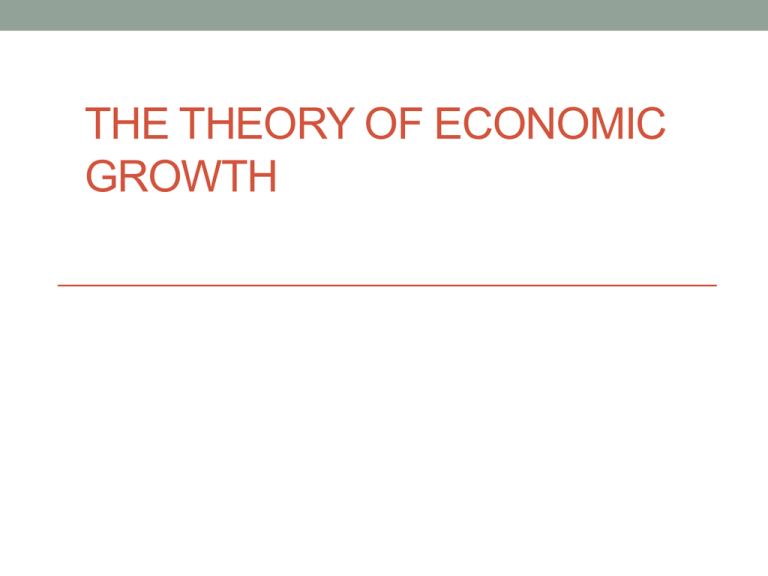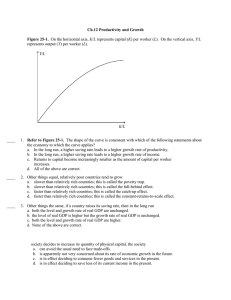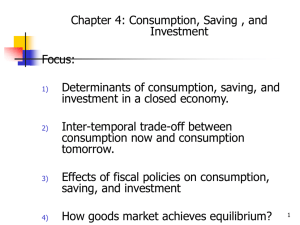THE THEORY OF ECONOMIC GROWTH 1
advertisement

THE THEORY OF ECONOMIC
GROWTH
1
2
Questions
• How important is faster labor-growth as a drag on
economic growth?
• How important is a high saving rate as a cause of
economic growth?
• How important is technological and organizational
progress for economic growth?
• How does economic growth change over time?
• Are there economic forces that will allow poorer countries
to catch up to richer countries?
3
American Real GDP per Capita, 1800-2004 (in
2004 Dollars)
4
Long-Run Economic Growth
• We classify the factors that generate differences in
productive potentials into two broad groups
• differences in the efficiency of labor
• how technology is deployed and organization is used
• differences in capital intensity
• how much current production has been set aside to produce useful
machines, buildings, and infrastructure
5
The Efficiency of Labor
• The efficiency of labor has risen for two reasons
• advances in technology
• advances in organization
• Economists are good at analyzing the consequences of
advances in technology but they have less to say about
their sources
“1974”
• There was a slowdown in productivity growth from approximately 1974 to around
1990.
• This is associated with the ITC (information and communications technology)
‘revolution’.
• Slowdown causes:
• Measurement – inadequate accounting for quality improvements
• The legal and human environment – regulations for pollution control and
worker safety, crime, and declines in educational quality.
• Oil prices – huge increases in oil prices reduced productivity of capital and
labor, especially in basic industries
• Kondratiev cycles
• 1873-1890 steam power, trains, telegraph
• 1917-1927 electrification in factories
• 1948-1973 transistor
7
Capital Intensity
• There is a direct relationship between capital-intensity and
productivity
• a more capital-intensive economy will be a richer and more
productive economy
8
Standard Growth Model
• Also called the Solow growth model
• Consists of
• variables
• behavioral relationships (aka laws of motion)
• equilibrium conditions
• The key variable is labor productivity
• output per worker (Y/L)
9
Solow Growth Model
• Balanced-growth equilibrium
• the capital intensity of the economy (K/Y) is stable
• This necessitates that the economy’s capital stock and level of real GDP
are growing at the same rate
• the economy’s capital-labor ratio is constant
10
Solow Growth Model
• After finding the balanced-growth equilibrium, we
calculate the balanced-growth path
• if the economy is on its balanced-growth path, the present value
and future values of output per worker will continue to follow the
balanced-growth path
• if the economy is not yet on its balanced-growth path, it will head
towards it
11
The Production Function
• The production function tells us how the average worker’s
productivity (Y/L) is related to the efficiency of labor (h)
and the amount of capital at the average worker’s
disposal (K/L)
(Y/L) F[(K/L), h]
Cobb-Douglas production function
(Y/L) (K/L) (h)1-
12
The Production Function
(Y/L) (K/L) (h)1-
• measures how fast diminishing marginal returns to
investment set in
• the smaller the value of , the faster diminishing returns are
occurring
13
The Cobb-Douglas Production Function for
Different Values of
14
The Production Function
(Y/L) (K/L) (h)1-
• The value of the efficiency of labor (h) tells us how high
the production function rises
• a higher level of h means that more output per worker is produced
for each possible value of the capital stock per worker
15
The Cobb-Douglas Production Function for
Different Values of h {or E in this particular plot}
16
The Production Function: Example
• h = $10,000
• = 0.3
• K/L = $125,000
Y K
1
0.3
0.7
h (125,000) (10,000) $21,334
L L
17
The Production Function: Example
• If K/L rises to $250,000
Y K
1
0.3
0.7
h (250,000) (10,000) $26,265
L L
the first $125,000 of K/L increased Y/L from $0 to
$21,334
the second $125,000 of K/L increased Y/L from $21,334
to $26,265
18
Saving, Investment, and Capital
Accumulation
• The net flow of saving is equal to the amount of investment
• Real GDP (Y) can be divided into four parts
• consumption (C)
• investment (I)
• government purchases (G)
• net exports (NX = X - M)
19
Saving, Investment, and Capital
Accumulation
I (Y T C ) (G T ) ( M X )
The right-hand side shows the three pieces of total
saving
household saving (SH)
government saving (SG)
foreign saving (SF)
I SH SG SF
20
Saving, Investment, and Capital
Accumulation
• Let’s assume that total saving is a constant fraction (s) of
real GDP
S S S
s
Y
H
G
Therefore, it must be true that
I sY
F
21
Saving, Investment, and Capital
Accumulation
• We will refer to s as the economy’s saving rate
• we will assume that it will remain at its current value as we look far
into the future
• s measures the flow of saving and the share of total production that is
invested and used to increase the capital stock
22
Saving, Investment, and Capital
Accumulation
• The capital stock is not constant
• We will let
• K0 will mean the capital stock at some initial year
• K2015 will mean the capital stock in 2015
• Kt will mean the capital stock in the current year
• Kt+1 will mean the capital stock next year
• Kt-1 will mean the capital stock last year
23
Saving, Investment, and Capital
Accumulation
• Investment will make the capital stock tend to grow
• Depreciation makes the capital stock tend to shrink
• the depreciation rate is assumed to be constant and equal to
24
Saving, Investment, and Capital
Accumulation
• Next year’s capital will be
K t 1 K t investment depreciation
K t 1 K t sYt K t
The capital stock is constant when
sYt K t
Kt s
Yt
25
Saving, Investment, and Capital
Accumulation
• Suppose that the economy has no labor force growth and
no growth in the efficiency of labor
• if K/Y < s/, depreciation is less than investment so K and K/Y will
grow until K/Y = s/
• if K/Y > s/, depreciation is greater than investment so K and K/Y will
fall until K/Y = s/
26
Saving, Investment, and Capital
Accumulation
• Thus, if the economy has no labor force growth and no
growth in the efficiency of labor, the equilibrium condition
of this growth model is
Kt s
Yt
27
Equilibrium with Just Investment and Depreciation
Output
per Worker
Equilibrium
(the reciprocal of the
capital-output ratio)
/s
K/L
(assumes that
and E are constant)
The capital stock
is growing because
K/L > /s
Capital Stock per Worker
The capital stock
is shrinking because
K/L < /s
28
Saving, Investment, and Capital
Accumulation
• Remember that, in this particular case, we are assuming
that
• the economy’s labor force is constant
• the economy’s equilibrium capital stock is constant
• there are no changes in the efficiency of labor
• Thus, equilibrium output per worker is constant
• Now we will complicate the model
Steady States
• Steady state: yt, ct, and kt are constant over time
• Gross investment must
1.
2.
•
•
•
Replace worn out capital
Expand so the capital stock grows as the economy grows, nKt
It = (n + d)Kt
Ct = Yt – It = Yt – (n + d)Kt
c = f(k) – (n+d)k


